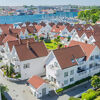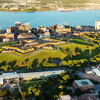16 Nights | Transatlantic
You will visit the following 10 places:

Copenhagen
Copenhagen is the capital and largest city of Denmark. This "friendly old girl of a town" is big enough to be a metropolis with shopping, culture and nightlife par excellence, yet still small enough to be intimate, safe and easy to navigate. Overlooking the Øresund strait with Sweden just minutes away, it is a cultural and geographic link between mainland Europe and Scandinavia. This is where old fairy tales blend with flashy new architecture and world-class design; where warm jazz mixes with cold electronica from Copenhagen's basements. You'll feel you've seen it all in a day, but could keep on discovering more for months. Copenhagen is considered a very liveable place because of its cleanliness. It’s considered as one of the very environmentally friendly cities because its harbour can be swum in and about a third of the city’s people use bicycles as their means of transportation. In their downtown area, the places to visit and to be entertained at are the Tivoli gardens and the Town Hall Square. If you want the very cultural and scenic areas the places to see are the Marble church, the Rosenborg castle, and the Christiansborg.

Boston
Boston is the capital of and largest city in Massachusetts, and is one of the oldest cities in the United States. The largest city in New England, Boston is regarded as the unofficial "Capital of New England" for its economic and cultural impact on the entire "New England" region. The city proper had a 2009 estimated population of 645,169, making it the twentieth largest in the country. It is also the anchor of a substantially larger metropolitan area called "Greater Boston", home to 4.5 million people and the tenth-largest metropolitan area in the country. Greater Boston as a commuting region includes six Massachusetts counties: "Essex", "Middlesex","Norfolk", "Suffolk", "Plymouth", "Worcester", northern "Bristol" County, all of "Rhode Island" and parts of "New Hampshire"; it is home to 7.6 million people, making it the fifth-largest Combined Statistical Area in the United States.

Stavanger
Stavanger is a city and municipality in Norway. The urban area of Stavanger stretches across many neighboring municipalities, making it the third largest city in Norway by total urban population with 197 852 inhabitants as of January 1, 2011. Stavanger's core is to a large degree 18th- and 19th-century wooden houses that are protected and considered part of the city's cultural heritage. This has caused the town centre and inner city to retain a small-town character with an unusually high ratio of detached houses, and has contributed significantly to spreading the city's population growth to outlying parts of Greater Stavanger. The city's rapid population growth in the late 20th century was primarily a result of Norway's booming offshore oil industry. Today the oil industry is a key industry in the Stavanger region and the city is widely referred to as the Oil Capital of Norway. Multiple educational institutions for higher education are located in Stavanger. The largest of these is the University of Stavanger.

Sydney
Sydney is a Canadian urban community in the province of Nova Scotia. It is situated on the east coast of Cape Breton Island and is administratively part of the Cape Breton Regional Municipality. Sydney was incorporated in 1904 and dissolved on August 1, 1995, when it was merged into the regional municipality. It is the largest urban centre on Cape Breton Island. Together with Sydney Mines, North Sydney, New Waterford and Glace Bay it forms the Industrial Cape Breton region. Sydney is located on east bank of the Sydney River where it discharges into South Arm of Sydney Harbour.

Halifax
Halifax, legally known as the Halifax Regional Municipality (HRM), is the capital of the province of Nova Scotia, Canada. It is a major economic centre in Atlantic Canada with a large concentration of government services and private sector companies. Major employers and economic generators include the Department of National Defence, Dalhousie University,Saint Mary's University, the Halifax Shipyard, various levels of government, and the Port of Halifax. Agriculture, fishing, mining, forestry and natural gas extraction are major resource industries found in the rural areas of the municipality. Halifax was ranked as the fourth best place to live in Canada for 2012, placed first on a list of "large cities by quality of life" and placed second in a list of "large cities of the future''. Additionally, Halifax has consistently placed in the top 10 for business friendliness of North and South American cities. Waterfront warehouses known as the Historic Properties recall Halifax’s days as a trading hub for privateers, notably during the War of 1812.

Reykjavik
Reykjavík is the capital and largest city of Iceland. It has a latitude of 64°08' N, making it the world's northernmost capital of a sovereign state, and is a popular tourist destination. It is the heart of Icelands's cultural, economic and governmental activity. The city itself is spread out, with sprawling suburbs. The city centre, however, is a very small area characterized by eclectic and colourful houses, with good shopping, dining, and drinking.

Lerwick Tingwall Airport

Akureyri

Skagen









